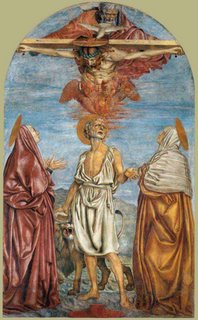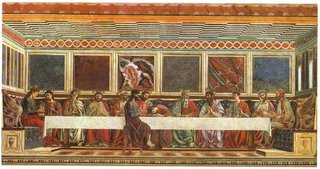Castagno

Andrea del Castagno died of plague on this day in 1457 in Florence, around the age of 36.
Castagno's reputation served a centuries-long prison sentence for a crime Castagno could not have committed: Vasari wrote that the violent Castagno was so jealous of the painting of his friend Domenico Veneziano that he murdered Domenico one night, and later confessed to the murder on his own deathbed. The only catch, unearthed in the 19th century, was that Castagno had died before Domenico.
While there is now no reason to believe Castagno was a murderer (thus freeing us for a more objective critical assessment of his work) it somehow seems appropriate to imagine that Castagno was an ill-tempered character: contrast his tortured, psychologically dark portraits of the saints with Domenico's serene figures, and the styles give a particle of truth to Vasari's lie.
By legend Castagno was a shepherd who liked to draw while he minded his flock when he was discovered by a member of the powerful Medici family, who brought him to Florence and arranged for him to serve in an apprenticeship with a master (possibly Domenico, Paolo Uccello or Fra Filippo Lippi). After gaining fame in Florence as "Andrea of the hanged men" for his painting of an execution at the Palazzo del Podesta, he painted for a time in Venice (notably the ceiling frescoes at Codussi's Church of San Zaccaria, 1442), and in 1444 he returned to Florence. His sculptural renderings of figures within organized, credible spaces were distinct from those of his contemporaries by the inner life he gives them through a variety of approaches.
His portrait of St. Julian at SS. Annunziata (c. 1454) is as subtle yet convincing a picture of murderous guilt as had ever been seen in Renaissance painting; his Vision of St. Jerome (c. 1454) by contrast, shows a broadly convulsive, agonizing wilderness prophet, perhaps the most dramatic portrait of religious ecstasy in its time. His masterpiece is an under-appreciated Last Supper (1447), tucked away in a refectory at S. Appollonia in Florence: Castagno paints the familiar scene with a series of marble panels appearing behind Jesus and his disciples, which panels seem to reflect the respective emotional states of the players; behind Judas Iscariot, the panel erupts in a violent, irregular pattern with contrasting colors, suggesting (in a manner which presages the 20th century idiom of Abstract Expressionism) the inner turmoil of Judas at the instant at which, traditionally, the devil seizes Judas's soul.

Labels: Italy, Painting and Sculpture





0 Comments:
Post a Comment
Subscribe to Post Comments [Atom]
<< Home